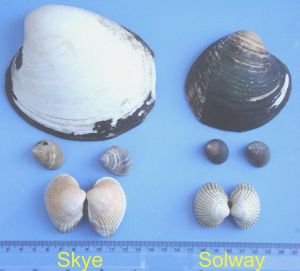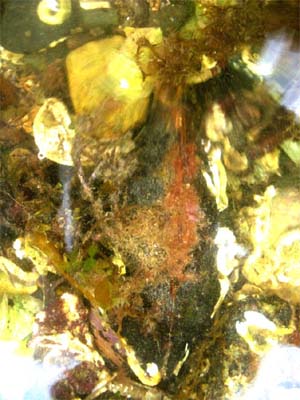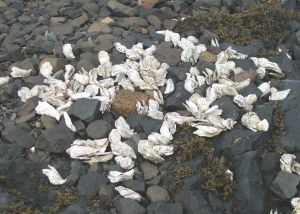|
While the other members of the Conchological Society on Skye were heading down to the lowest areas of the shore and washing samples from sand, weed and other substrates for minute shells, Pauline and I concentrated on the larger shells washed up on the beaches. As we were staying on Skye for a week either side of the Conchological Society field trip we were able to survey several additional beaches around Skye. Altogether we visited 15 beaches and found 55 species of shells. When I first joined the Conchological Society I started using its methods for carrying out beach surveys. At first I thought that they should be much more standardised and that all surveys should be carried out at a particular tide level, over a specific area of beach or over a specific time scale so that they could be compared. After several beach walks I realised how effective the Conchological Society method was. The main object is to discover which shells occur in the area with some indication of numbers. If you restrict the survey you may miss some species. The best method is to spend as much time as you can on the beach covering as much of the beach as possible. If you can visit the beach more than once, so much the better. Shells can accumulate at different points on the beach for no apparent reason. On several occasions we have found that one species of shell occurred in large numbers at one end of the beach while it was absent on the rest of the beach. On other beaches the majority of shells are found in a few piles on an otherwise relatively shell free beach. For instance, on a recent 2,500 yard walk along a Welsh beach we found only a few individuals of 5 shell species apart from two small areas of beach each about 3 metres wide by 5 metres long which contained many shells of 25 different species. Curiously, two days later everything had changed and the whole tideline of the same stretch was littered with large numbers of shells of 32 different species.
The shells found on the beach are a good way of discovering which molluscs live in the area but it does have its limitations. Some shells may be from animals that died a while ago and no longer live there. For instance, on Skye we found several Hinia reticulata shells as did other searchers but no one found any live specimens. The more robust shells can last for several years as can be seen from mature barnacles and worm tubes seen on the inside surfaces of some shells such as Dosinia sp., Arctica islandica, and others and will be over represented. Thin shells, like those of Angulus sp., are very fragile, break up quickly on any but very sheltered beaches and will be under reported. Despite these points, surveys of the shells found washed up on the shore are very useful as an indication of the molluscs that live in the area. If you cannot dive or trawl for shells and live specimens they are the only way of finding out which molluscs live below the low tide mark. I was surprised how many of the shells on Skye were familiar to me from my usual hunting ground on the north coast of the Solway Firth near Kirkcudbright. One main difference was the size of some of the shells. On Skye Cerastoderma edule (figure 2, bottom) grew to almost 40 mm at three years compared with around 25-30 mm in the Solway. One large Littorina littorea shell was 36.6 mm and many were around 30 mm whereas L. littorea in the Solway seldom grow beyond 25mm and most are around 20mm (Figure 2, centre). On Camas Croise we found two Arctica islandica 111.6 mm and 118.4 mm across each attached to a frond of Lamminaria saccharina. Specimens found in the Solway usually are less than 80 mm (figure 2, top). Some shells were different from those found in the Solway. Modiolus modiolus, Chlamys nivea, Tapes aureus and Tapes decussatus occurred on several Skye beaches. Cochlodesma praetenue and Angulus squalidus were found on two of the beaches and a single very worn Tridonta montagui was found at Armadale Bay. We also found a pile of fresh empty Crassostrea gigas shells on the beach near the Talisker distillery. Possibly someone wanted oysters to go with their dram. We spent one morning on the Glass Bottomed Boat from Kyle of Lochalsh. It is not actually glass bottomed but it has an area below the waterline with viewing windows. It was a thrilling experience even though there was an algal bloom which limited visibility to a few metres. We saw many shells on the sea bottom – mainly Mya arenaria, M. truncata and Ensis siliqua as well as a many fish, sea urchins, and Laminaria forests. Dead man’s fingers (Alcionyium digitatum) and other marine life were seen on an old shipwreck. This is a trip well worth doing if you are up at Kyle of Lochalsh. |
Figure 1: Jim and Pauline searching for shells (Photo: Margaret Brown)
Figure 2: Comparison of sizes of shells from skye and Solway (Photo: Jim Logan)
Figure 3: Modiolus modiolus living on the lower shore, Skye (Photo: Peter Topley)
|
A search for shells on the beaches of Skye
Issue
22
Page
14



 Figure 4: Crassostrea gigas near Talisker Distillery (Photo: Jim Logan)
Figure 4: Crassostrea gigas near Talisker Distillery (Photo: Jim Logan)